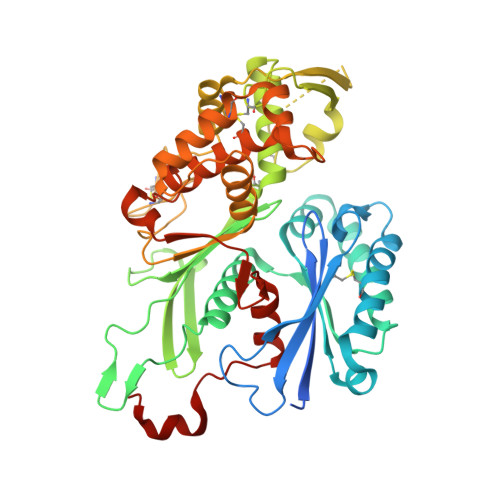Structural insight into signal conversion and inactivation by NTPDase2 in purinergic signaling
Zebisch, M., Strater, N.(2008) Proc Natl Acad Sci U S A 105: 6882-6887
- PubMed: 18458329
- DOI: https://doi.org/10.1073/pnas.0802535105
- Primary Citation of Related Structures:
3CJ1, 3CJ7, 3CJ9, 3CJA - PubMed Abstract:
Cell surface-located nucleoside triphosphate diphosphohydrolases (NTPDase1, -2, -3, and -8) are oligomeric integral membrane proteins responsible for signal conversion and inactivation in extracellular nucleotide-mediated "purinergic" signaling. They catalyze the sequential hydrolysis of the signaling molecule ATP via ADP to AMP. Here we present the structure of the extracellular domain of Rattus norvegicus NTPDase2 in an active state at resolutions between 1.7 A and 2.1 A in four different forms: (i) apo form, (ii) ternary complex with the nonhydrolyzable ATP analog AMPPNP and cofactor Ca(2+), (iii) quaternary complex with Ca(2+) and bound products AMP and phosphate, and (iv) binary product complex with AMP only. Analysis of the ATP (analog) binding mode explains the importance of several residues for activity and allows suggestion of a catalytic mechanism. The carboxylate group of E165 serves as a catalytic base and activates a water molecule, which is well positioned for nucleophilic attack on the terminal phosphate. Based on analysis of the two product complex structures in which AMP adopts different conformations, a substrate binding mode for ADP hydrolysis is proposed. This allows for an understanding of how the same hydrolytic site can be engaged in ATP and ADP but not AMP hydrolysis.
Organizational Affiliation:
Center for Biotechnology and Biomedicine, Institute of Bioanalytical Chemistry, Faculty of Chemistry and Mineralogy, University of Leipzig, Deutscher Platz 5, 04103 Leipzig, Germany.
















